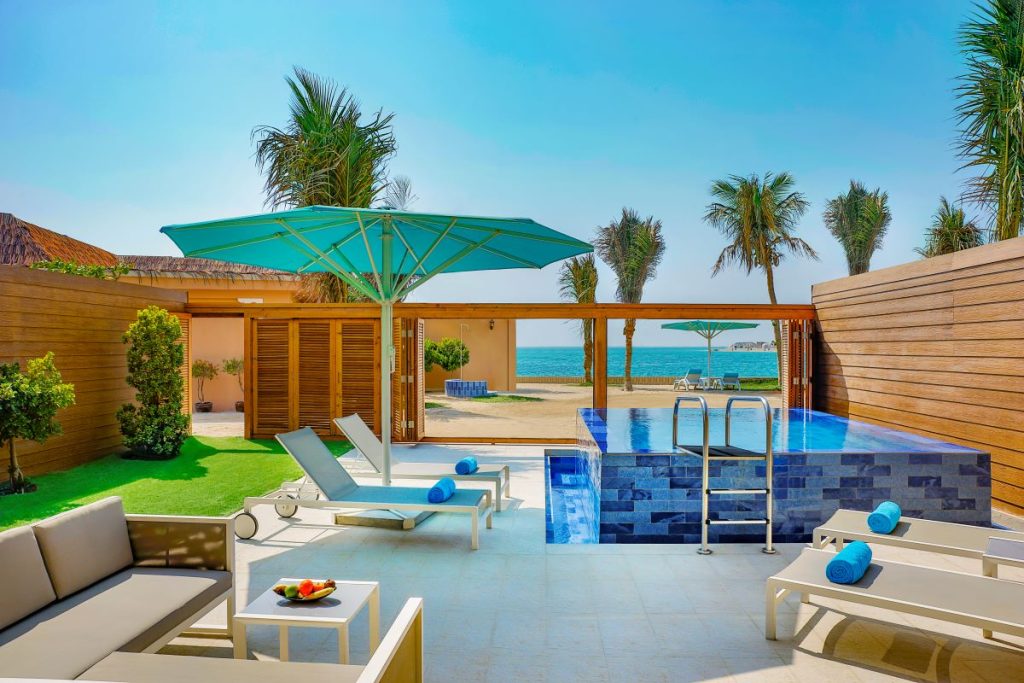The question isn’t “Where can we go this weekend?”—it’s “How far do we want to feel we’ve gone?” That’s how staycations work in Dubai. With landscapes as varied as the Liwa dunes and the Arabian Gulf, the city offers escapism within its limits. And no, we’re not talking about hotel brunches followed by a swim. A true Dubai staycation might include stargazing beside a bonfire, hammam rituals in marble spas, or waking to the sound of dhow horns in Al Seef. The diversity isn’t accidental. In 2025, hospitality zones are classified under urban, desert, coastal, and heritage themes by DET, shaping how hotels and resorts craft experiences. This helps residents match mood with destination, without worrying about visas, flights, or long check-ins.
You need to pick a theme before you pick a location
One of the biggest mistakes people make is choosing by name, not by atmosphere. Atlantis, Burj Al Arab, and FIVE might be famous, but they’re not for everyone. A family of five with two toddlers probably won’t relax at a rooftop pool bar where music starts thumping at 2 p.m. Similarly, couples seeking quiet shouldn’t book beachfront properties during school breaks. That’s why experienced locals pick their staycations based on themes. If they want desert solitude, Al Maha or Bab Al Shams come up. If they’re after cultural immersion, places like Al Seef Heritage Hotel or Ahmedia Guest House in Deira make sense. Want something that feels international? Resorts like Nikki Beach or Bulgari offer that Ibiza or Amalfi air. But if you don’t think in themes first, you might end up with an Instagrammable nightmare.
Desert stays feel like you’ve left the UAE altogether
Let’s start with something often overlooked: the desert isn’t just empty space. It’s a sanctuary. Resorts like Al Maha, located within the Dubai Desert Conservation Reserve, offer complete silence, unpolluted skies, and the kind of privacy few city hotels can provide. In 2025, bookings here include desert drives with licensed conservationists, sunset camel rides, and private villa plunge pools that overlook roaming gazelles. You might not check your phone for hours. And that’s the point. Staff are trained not just in hospitality but in storytelling. They’ll tell you why scorpions hide under cool rocks at noon, or how falcons are weighed before hunting season. A desert staycation is less about luxury and more about rewilding your rhythm. That said, luxury is still there—only with sand between your toes.
Staycations in Dubai Marina offer skyline views and urban pulse
If your version of relaxing includes dining with views of superyachts, Dubai Marina delivers. High-rise hotels like Address Dubai Marina or InterContinental have curated “mini-break” experiences that start from late Friday check-in and end with Sunday lazy brunches. These aren’t cookie-cutter getaways. Some include in-suite barista setups, spa vouchers, or even rooftop yoga. The Marina is walkable, which makes it appealing. From your hotel lobby, you can reach Pier 7, the beach, or the new Bluewaters pedestrian bridge in under 20 minutes. In 2025, mobility services around Marina have expanded. Most hotels now partner with electric scooter providers or offer shuttle golf carts for guests. This makes the entire zone feel like a giant holiday compound. It’s not cheap, but it saves you airfare.
Al Seef and Deira let you sleep inside the city’s old soul
Dubai’s older quarters aren’t just for day trips. In fact, staying overnight in Deira or Al Seef changes how you see the city. Places like Al Seef Heritage Hotel recreate traditional courtyard homes, complete with wind towers and coral brick exteriors. But don’t be fooled. Behind those wooden doors, you’ll find rain showers, organic cotton bedding, and curated coffee blends. The point is balance. In the morning, you might hear the call to prayer echoing from multiple mosques. By lunch, you’re walking distance from creekside art galleries or spice markets. And at night, you can take a dhow ride under lantern-lit skies. This kind of staycation doesn’t feel “designed.” It feels like being temporarily adopted by Dubai’s memory.
Palm Jumeirah delivers glam, but each crescent offers something different
Palm Jumeirah is the first choice for many looking to escape without leaving the emirate. But not all parts of the Palm are equal. The East Crescent, home to resorts like Waldorf Astoria and Anantara, caters more to wellness seekers and families. Meanwhile, the West Crescent is known for parties and nightlife—FIVE Palm Jumeirah being the undisputed hotspot. Central areas, like the trunk, give access to Nakheel Mall and The Pointe, ideal for staycationers who want walkability and casual dining. In 2025, Atlantis The Royal now features private sky pools and a culinary complex where each restaurant has a Michelin-level concept. The Palm is no longer a single destination. It’s a microcontinent. Choosing the right crescent makes or breaks the vibe.

Eco-lodges and glamping experiences are growing near Hatta
Not everyone wants marble bathtubs and all-you-can-eat buffets. Some prefer fresh air and the smell of firewood. That’s where eco-staycations in areas like Hatta come in. In 2025, the Dubai Municipality has approved several new eco-lodge licenses, requiring solar energy use, water recycling, and integration with natural landscapes. Whether it’s Sedr Trailers or Damani Lodges, these accommodations blend canvas, wood, and minimalism. There’s also Terracotta Retreats—domes with glass skylights for desert star-watching. These aren’t just cute cabins. They’re part of a growing movement toward conscious travel in the UAE. For many Dubai residents, they offer the perfect detox from five-star repetition. You breathe differently in Hatta.
Hotels now design packages specifically for UAE residents
In recent years, Dubai hotels realized that competing with outbound travel meant going beyond discounts. So they created resident-centric packages. These include late checkouts, in-room breakfasts, spa credits, and activity passes. Some even offer school-friendly options like half-day kids’ camps, making it easier for parents to relax. In 2025, hotels use Emirates ID verification for these packages. While some perks existed before, they’re now more organized and advertised as “staycation exclusive.” For example, The Ritz-Carlton in JBR has a “UAE residents only” beach day plus spa bundle. Similarly, Sofitel The Obelisk introduced cultural immersion weekends with Arabic calligraphy and Emirati cooking workshops—all without leaving the hotel. These aren’t gimmicks. They’re thoughtful adaptations to local demand.
Wellness-centered staycations appeal to those seeking silence and physical reset
Some people don’t want adventure or family chaos on their weekend break. They want wellness. For these residents, places like Talise Spa in Madinat Jumeirah or One&Only The Palm create experiences focused entirely on balance. In 2025, these resorts include sleep therapy sessions, digital detox rooms, and even circadian light programs. That means your room adjusts lighting based on your natural sleep-wake cycle. Nutritionists are on-site to create personalized meals based on your body needs, not a buffet. Guests often book for three nights but extend once they feel their mind settling. You’ll see people reading on shaded terraces, not scrolling. Some properties now even offer private mindfulness coaches who integrate desert walks, water breathing, and guided visualization. This isn’t luxury for Instagram. It’s health for your nervous system.
Cultural staycations let residents reconnect with the city they live in
There’s a strange irony in living in Dubai for years and not understanding its historical layers. Staycations help fix that. For residents who want to step away from the skyscrapers and reconnect with Dubai’s roots, cultural hotels in Al Fahidi or Satwa are game-changers. Some offer guest talks by local historians, while others provide exclusive access to mosques or cultural houses. In 2025, the UAE Ministry of Culture partnered with several properties to create weekend immersion packages. These include Al Farooj cooking classes, Emirati dialect lessons, or guided walks through vanished neighborhoods. You leave knowing what barjeel means or why coral stone was once used in construction. These aren’t tourist attractions. They’re living archives.
Kid-focused staycations solve boredom without needing a flight
Every parent knows the struggle: “Where can we go that’s fun for them and relaxing for us?” That’s where kid-friendly staycations come in. Hotels like Lapita (inside Dubai Parks and Resorts) or JA The Resort offer water playgrounds, supervised movie nights, and even mini zip-lines. In 2025, many family resorts have upped their game. Rooms come with game consoles, kids’ spa menus, and snack fridges stocked by request. What’s different now is the attention to age diversity. You’ll find spaces for toddlers, tweens, and teens. Some even have teen-only lounges where adults aren’t allowed—because let’s face it, teenagers need their own vibe. Meanwhile, parents can get a massage or read poolside without guilt. That’s what makes a weekend feel like a vacation, not a chore.


 then "Add to Home Screen"
then "Add to Home Screen"